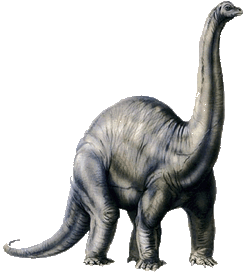
Vulcanodon ("volcano tooth") is an extinct genus of sauropod dinosaur from the Early Jurassic of southern Africa. Discovered in 1969 in Rhodesia (now known as Zimbabwe), it was regarded as the earliest known sauropod for decades, and is still one of the most primitive sauropods that has been discovered. As a quadrupedal, ground- dwelling herbivore, Vulcanodon already showed the typical sauropod body plan with column-like legs and a long neck and tail. It was much smaller than most other sauropods, measuring approximately 6.5 metres (20 ft) in length. Vulcanodon is known from a fragmentary skeleton including much of the pelvic girdle, hind limbs, forearms, and tail, but lacking the trunk and neck vertebrae as well as the skull. Originally, this genus was believed to be a prosauropod because of the knife-shaped teeth found near its fossils, which fit in with the idea that prosauropods were omnivorous. Scientists now know that the teeth belonged to an unidentified theropod that may have scavenged on the Vulcanodon carcass. Vulcanodon is now known to be a true sauropod.
Etymology[]
Vulcanodon was named by Michael Raath in 1972. The name points to the fact that the skeleton was found in a small body of sandstone that is sandwiched between two lava flows, and emphasizes the peculiar knife-shaped teeth that are now known to belong to a theropod. The species name, karibaensis, refers to the place of discovery on a small island in Lake Kariba.
Description[]
Vulcanodon was a small sauropod, measuring approximately 6.5 m (21 ft) in length. As one of the earliest and basal most sauropods, it is important for understanding the early evolution of this group. Sauropods descend from basal sauropodomorphs, which were primitively bipedal. While Vulcanodon already was fully quadrupedal , its limb proportions were intermediate between those of its prosauropod ancestors and those of later, more derived sauropods. Its forelimbs were much more similar to later sauropods than basal sauropodomorphs because they are straight, much more gracile, and the proximal end of the ulna is v-shaped. Unfortunately, no skull or neck of Vulcanodon is known, although it is otherwise very well-known.